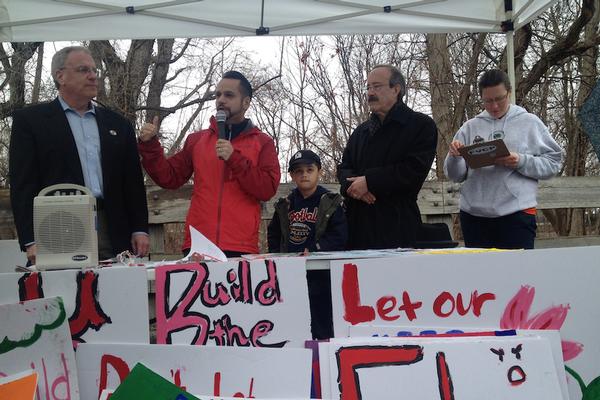
Photo by: Jordan Moss
Assemblyman Jeffrey Dinowitz, State Sen. Jose Serrano, Jr. and Congressman Eliot Engel address demonstrators who want the city to take a modest step to repair the damage done to a flagship park by decades of invasive infrastructure projects.
The bitter decade-plus community battle against the plan to build the Croton water filtration plant on the east side of Van Cortlandt Park didn’t succeed: The city finalized its site selection back in 2004. Yet the completion of the massive facility is five years delayed and is on track to cost more than $2 billion beyond its 2003 budget.
But park activists, politicians and community groups continue their push for a relatively small construction project that the City Council had studied and recommended in 1999: a walking bridge over the Major Deegan expressway connecting the east and west sides of the park, which, with 1,146 acres, is the fourth largest in the city.
In 2011, the Department of Environmental Protection said the $6 million that they predict the bridge would cost is money they don’t have.
“That is their stated barrier. It’s genuinely insulting of the DEP in the context of the filtration plant,” says Councilman Andrew Cohen, referring to that cost being a minute fraction of the plant construction cost.
Three years later, the agency’s position remains the same, according to a statement released this week: “New Yorkers want DEP to stay focused on keeping their water bills as low as possible, which means ensuring that our resources are only used for critical projects that will ensure a reliable source of high-quality drinking water and continue to improve the health of New York harbor,” the agency said.
DEP also said that elected officials didn’t include the bridge in their list of park-improvement projects to be covered by a $200 million fund that was created to compensate the Bronx for the impact of the filtration project.
Dart Westphal, a Van Cortlandt Village resident who helped lead the filtration plant battle for more than a decade, finds the DEP’s current claim incorrect. “The agreement to study, and ‘if feasible,’ build the bridge was in the City Council resolution that decided on the location of the plant,” he said, referring to the 1999 document. “It had nothing to do with the subsequent agreement to allow alienation by the state legislature in return for the $200 million-plus in park renovations.”
To announce their plans for an unrelenting push to get the bridge construction started, about 60 people gathered on Saturday in the cold rain for a press conference at the Shandler Recreation Area on the far-east side of the park, just north of the filtration plant construction site.
Friends of Van Cortlandt Park and Community Board 8 organized the event. It featured many people who were involved in weekly and monthly meetings fighting the plant beginning in the early 1990s, including Westphal, advocate Karen Argenti, Assemblyman Jeffrey Dinowitz and Congressman Eliot Engel.
“We are going to continue to make noise and we’re not going to stop until that bridge is built,” Engel said.
With its bike and running trails, streams and brooks, Bob Bender, chair of Community Board 8’s Parks Committee referred to the park as a “jewel” and a “gem.” But he also pointed out the three different highways that “slice and dice” the park—the Major Deegan/I-87, the Henry Hudson Parkway and Mosholu Parkway.
“Anyone who wants to get around this park has a very hard time doing it, and now we have an opportunity to start putting this park together again, to start making it whole, the way it once was before the highway planners got hold of it and stuck the highways in there and the DEP got hold of it and stuck a filtration plant in here,” Bender said. “We can reunite the communities that live around this park, so that people on the east side of the park can use the west side of the park and vice versa.”
Dinowitz, who has been involved in the issue since he became assemblyman in 1994, believes that the DEP is punishing the community for its two-decade activism opposing the filtration plant.
“When you have a project in Van Cortlandt Park that’s over $2 billion over budget, it’s a little hard to believe that the few millions that are involved in building this bridge makes it not feasible,” he said at the press conference. “This is a deliberate choice of the DEP not to do what’s right for our community.”
Community leaders based far from Van Cortlandt Park see the bridge as an issue relevant to the borough and beyond. Chauncy Young, a Highbridge Coalition activist who was a leader in getting the High Bridge, connecting the southwest Bronx and upper Manhattan, rehabbed, to be reopened soon. Both Van Cortland Park and the High Bridge cover southern connections of the Croton Aqueduct that begins in northern Westchester.
“The bridge is going to open in Highbridge,” Young said, “and the bridge needs to open here in Van Cortlandt Park.”
Councilman Cohen, in office for only three months, said he was feeling positive in anticipation of his meeting with DEP this week.
“One thing about being the new guy is I’m optimistic,” he said.








